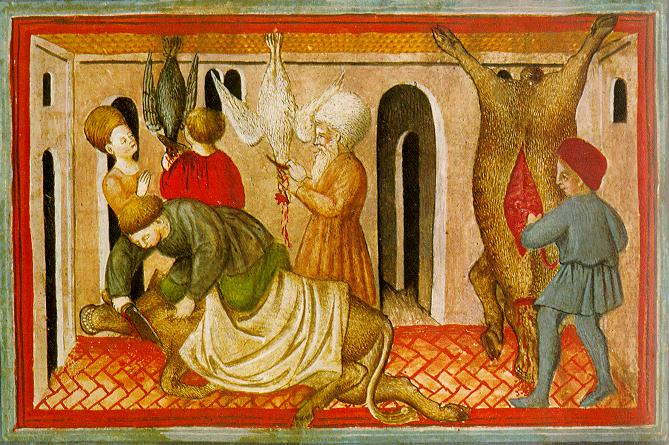
Brain Fritters and Sephardi Offal
Image credit (A 15th-century depiction of shechita and bedikah)
The Symposium’s President, Claudia Roden, shares a recipe for brain fritters and considers the place of offal in Sephardic communities.
Fritas di Meyoyo / Brain Fritters
These delicate fritters, crisp outside and deliciously soft and creamy inside are popular throughout the Sephardi world.
Serves 6
2 calf’s or 4 lamb’s brains
Salt
1 1/2 tablespoons vinegar
Flour
White pepper
2 eggs, lightly beaten
2 lemons cut into wedges
Soak the brains in cold water with 1 tablespoon of vinegar for 1 hour. Remove the membranes carefully and rinse in cold running water. Lower into boiling salted water, acidulated with 1/2 a tablespoon of vinegar, and simmer for 4 minutes until they begin to firm.
Lift them out, cut into thick slices and let them dry. Dip in flour seasoned with salt and pepper, then in the egg so that they are well coated all over. Deep-fry in hot oil, turning over once, till golden brown all over. Drain on kitchen paper and serve hot with lemon wedges.
Sephardi Offal
My grandfather once caught his kosher butcher buying offal from an Arab at the market in Cairo. The butcher excused himself saying: “You all want offal. How many animals do you think I would have to kill to have enough for all of you?” The offal everybody was after included liver, brains, sheeps’ head, tongue, spleen, stomach, heart, tripe, testicles, cows udder, feet and intestines.
Even though offal was poor food, they were considered a delicacy. Every community had its favourites. The Judeo Spanish Sephardim were especially fond of brains and also of feet. North African Jews adored tongue, spleen and tripe. Only the Yemenites and North Africans have kept up their dishes. While the Anglo Saxon environment has not been propitious for this kind of cuisine, French kosher butchers display a marvellous array of beautifully cut, cleaned and sometimes ready-cooked pieces. Some of the dishes combine a variety of offal. Tunisian aakode is a stew of stomach, tripe, stuffed intestine, testicles, and penis with harissa, cumin, paprika and tomato concentrate. Algerian faad d’agneau – is the lungs, heart, liver, oesophagus and entrails of a lamb, cooked with garlic, tomato, onion and parsley. Moroccan tagine del guezar is stewed liver, spleen, heart, lungs, head, feet, sausage of beef intestine filled with liver cooked with a yellow sauce (garlic and turmeric) or a red sauce (cumin and paprika).
It is interesting to note that a stew with sheeps’ feet and head and tripe and intestines stuffed with spicy minced meat, as well as meatballs flavoured with cinnamon and coriander cooked in a vinegar, mustard and raisin sauce were sold at the market in thirteenth century Andalousia for the Sabbath. (Lucie Bolens “La cuisine andalouse et l’art de vivre XIe – XIIIe siecle”)
Reprinted, with permission, from The Book of Jewish Food by Claudia Roden. Published by Penguin, 1999.
